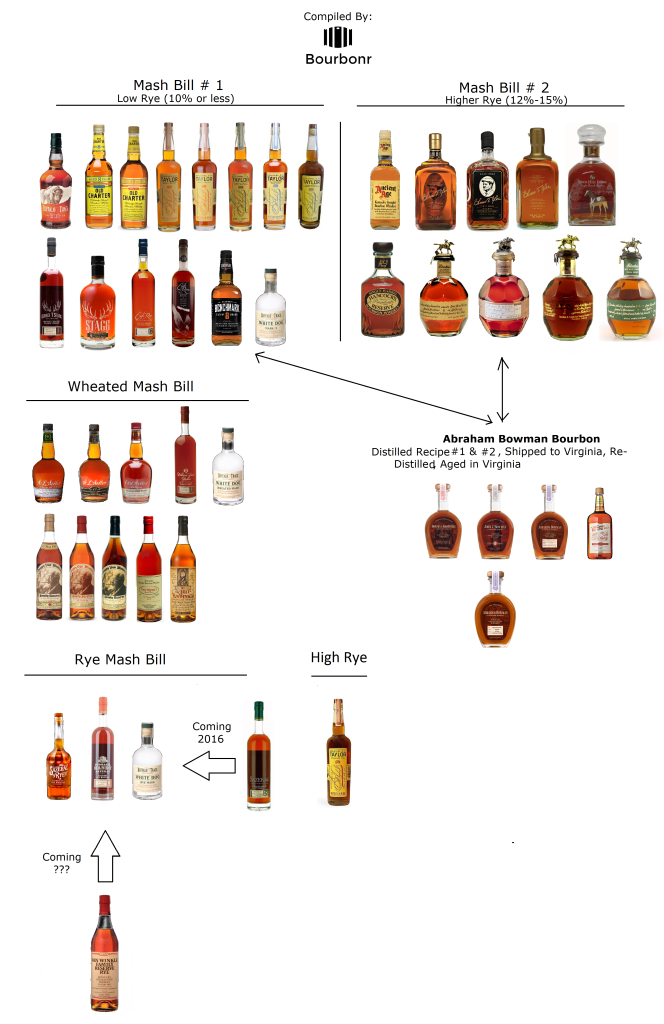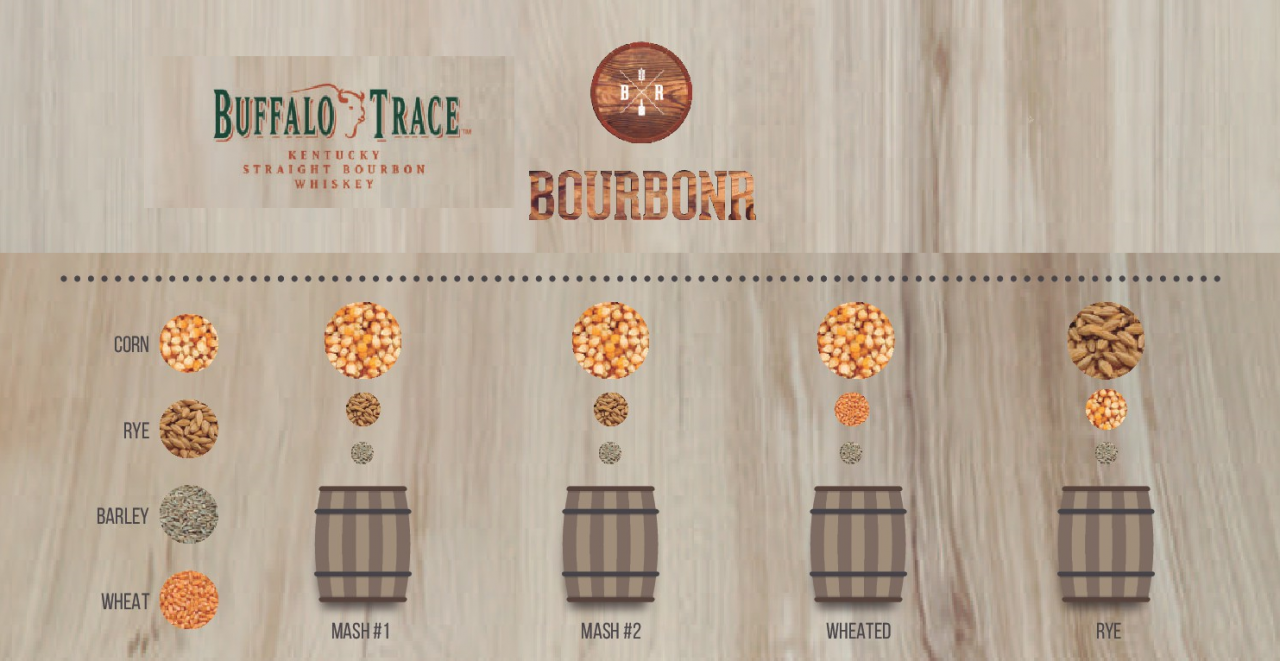Updated: Buffalo Trace Distillery Mash Bills
Almost four years ago I created my first distillery mash bill breakdown for Buffalo Trace. There have been several changes since then. I decided it was time for an updated and expanded version. I’ve tried to focus on whiskeys that are distilled (at least once) at Buffalo Trace distillery. The Buffalo Trace/Sazerac/Age International/Barton brand(s) is an intricate web.
Major Changes:
– All Van Winkle bourbons are now from the Buffalo Trace wheated mash bill
– The Van Winkle rye is still from a different source (probably Bernheim or Medley) and there’s not an official word on when this supply will run out. If I had to guess I’d say 2017.
Hi-res Buffalo Trace Mash Bill Breakdown
Buffalo Trace uses two primary mash bills. While they don’t disclose the exact recipe we can make educated guesses at the mash bill percentages. Mash bill # 1 is probably 10% or less and mash bill #2 is somewhere between 10%-12%.
The wheated bourbon mash bill is a mystery as well. However, the rye portion (and maybe more) is replaced by wheat. This creates a very different flavor profile than the Rye. I also believe that wheated bourbons handle (even need) aging much better than bourbons that have rye in the mash bill. See Buffalo Trace Master Distiller, Harlen Wheatly’s comments about this in my post about bourbon aging.
The rye mash bill is thought to be 51% rye. Just enough to be legally considered rye whiskey but still enough corn to bring out the familiar taste of bourbon. These low-rye rye whiskeys are much different than the currently popular high (some up to 95%) rye whiskeys.

The point of this post is to show how much of a difference small factors in aging affect a bourbons taste. By simply aging in a different warehouse two, bourbons that entered the barrel with the same mash bill and same proof can have a completely different taste and proof.




71 comments
Blake, the Taylor rye is a distinct mashbill, likely no-corn — just rye and malt.
Good catch, Mitch! I forgot to split it out.
I want to put my email for early release of Pappy. Where can I do this?
Stop that.
Nice work. Thanks, Blake!
Can you cite a source for Bowman as mashbill 2? I’ve always been under that impression but dug around a while back and could find no reliable source.
It’s actually both. This is the response I got from BT “It varies, as the Abraham line is sort of like BT’s experimental line, meaning it’s different every time. We’ve used both mash bills for it before, depending on the product, so I really can’t give you a definitive answer on that”
Bowman whiskeys use their own mash bill recipe, it is not BT product aside from where the distillate is produced. I toured the Fredericksburg facility last weekend (bought a used barrel) and the tour guide was explicit in this point – 71% corn, 23% single source Virginia rye, and 5% barley (must be a rounding error as this adds up to 99%). The yeast is also Bowman’s own proprietary strain. Bowman has acquired the adjacent warehouse in Fredericksburg and is planning expansion, which could mean the return of fermentation to Virginia. She also indicated this would mean return of their equipment from BT, though she didn’t mention what equipment that was, though the implication was that BT uses the old Bowman legacy kit from when production was moved there.
They may do that. But, that’s not the majority of their production. They still don’t have the capacity to maintain the production levels they have. BT has confirmed it’s shipped from the Frankfort distillery to VA
I’m not following you completely. Yes, of course all of Bowman’s distillate is shipped from Kentucky to Va. But all of its distillate is made from Bowman yeast and Bowman mash bill, with a Virginia rye that I really doubt BT uses for any other product. I’m not sure what you were saying about production levels. Bowman gets all they need now, and if they move production back to Virginia again they won’t do so without ensuring production levels can be maintained.
Another thought, the guide said that Bowman had 200 employees prior to being acquired by Sazerac, but they now have 16. There would be quite a period of time before they could ramp back up again to handle the fermentation, if that’s what they decide to do.
Sorry, I misread your comment. However, I still don’t believe that to be true. I’ve been told by BT employees that it’s both mash bill #1 & #2. I don’t BT is doing completely separate runs to ship to VA. I could be wrong but I don’t put a lot of faith in tour guides.
I know I’m coming in late on this thread but I felt it necessary to mention that some comments have been made in a bourbon forum that staff at A. Smith Bowman distillery have denied any association with Buffalo Trace in terms of having a “mother liquor” supplied to them for further refinement and aging. Apparently the claim was that they have always had sole responsibility over their product. Anecdotal and here say, but it is an interesting topic to have settled once and for all as people have claimed how similar the Single Barrel – John J. Bowman juice is to Blanton’s. I can taste some similarity, regardless, both are excellent.
Thank you for your research and graphical products, very well assembled, nice work!
I’m sure they may say that. But, if you look at the still they’re running and the barrels they have, it doesn’t add up. Plus, this info came directly from Buffalo Trace
Nice work Blake! Thanks for keeping us informed. I was at BT last Friday for the Weller tasting and I asked the tour guide how they pick what Blanton’s becomes what (US Single Barrel, Gold, Silver etc) and he didn’t know all he would say is they have no plans on ever selling any of the other ones here in the states. So do you know how they pick what barrel becomes what kind of Blanton’s?
Blake – 3 ETL bottles are pictured above. The middle is the Commemorative. Are the left and right both ‘regular’ single barrel? Difference btw the two, besides label, picture and foil/wax?
3 proof difference is all
I saw a note on a new release. . .”Walking Stick” SB from BT. Is this correct and on your radar?
I’ve read elsewhere that Walking Stick is a Sazerac product, but it is distilled at the 1792 distillery and has nothing to do with Buffalo Trace. I’m still interested in it though.
I went through BT the other night prior to the ETL dinner and our tour guide stated Walking Stick was not Mash#2 but was the same mash as VOB distilled at 1792 Barton just bottled at BT. Obviously not an authoritative source but thought I’d corroborate.
Sound there goes the rarity of Pappy using the old German wheat that was aged for their bourbons. Now their bourbon is like others who can simply use wheat in their mash bill as well.
I apologize if this is slightly OT but the latest email from Ezra’s indicates that Buffalo Trace is “on allocation”! Any other indications of this? Perhaps just a ploy to induce panic buying?
Quote from Ezra’s email:
“Buffalo Trace is the equivalent of a having a hot dog at a baseball game. It’s the de facto bourbon that everyone has had at some point. Unfortunately now has become an allocated product, so don’t miss this opportunity to grab some.”
Yes, it’s on allocation. Meaning retailers can’t just order at will but it’s still far from a shortage
Great work as usual Blake. FYI, I’ve been told by BT that Bowman uses both rye recipes for its bourbons, though they wouldn’t specify which were used for which bottlings.
Thanks, Steve! Just adjusted the chart accordingly.
I’m fortunate enough to have a couple of 20-yr old Pappy’s which I acquired sometime in the last 5-6 years. Is there any way to tell (from the labeling) what year they were bottled? I know that these bottles would sell on the 2nd-ary market for north of $1,000 (not that I’m selling), but the bottling year seems to matter as to the price.
Yes. There are two different bottling codes. One will start with a letter such as B. The second type of code would end with a letter such as K. You would have one of those two types of codes on your bottle. If you reply with the code, I will decipher it for you.
Buffalo Trace says that Benchmark is an “80 Proof ‘Rye Recipe’ Kentucky Straight Bourbon Whiskey”. So why is it listed under the lower rye mash bill?
It actually says the same thing about Old Charter.
http://www.buffalotracemediakit.com/bourbons.html
That’s what they mean by the recipe. It’s a rye recipe bourbon as opposed to a wheatead recipe bourbon
Very nice info thanks.
Walking Stick is no doubt .. buffalo trace.. if you blind tasted buffalo trace .. eagle rare..and walking stick.. you would not beable to guess correctly .. reason ? It’s the same juice
Walking stick is indeed Single Barrel Barton “juice”.
Never had Walking stick but I can definitely taste the difference between Buffalo Trace and Eagle Rare. I like them both.
will buffalo trace continue to produce van winkle rye? or is it being discontinued all together? any reason to hold onto my bottle for value sake?
Negative. Drink it or trade to me!
Hello I was arguing with a friend about sourcing and he says the Buffalo Trace doesn’t source. Is that true
Are you asking if they buy from other distilleries? Or, if they sell to other brands? The answer to both questions is technically no at this point. But, other brands have sourced from BT in the past. And, you could consider Mash Bill #2 a sourced product since BT doesn’t own these brands.
Hello yes I was actually asking if they sell two others but your Anta thank you I appreciate your time. Actually do you know when the last time they did sell and who it was thank you Brian
I’m not sure. It’s probably been a while.
Hi there im a really big fan and was wondering if you could send me a few stickers or poster please my name is julie Rafine 110 highland avenue pennsville nj 08070 thanks sincerely Julie
Rock Hill Farms Bourbon is a true connoisseur’s choice, delivering an exceptional and distinctively smooth drinking experience. Meticulously handcrafted at the historic Buffalo Trace Distillery, this small-batch bourbon is renowned for its rich complexity and well-balanced flavors. With a velvety texture and notes of caramel, vanilla, and a hint of spice, Rock Hill Farms Bourbon stands as a testament to the artistry of bourbon making. Elevate your spirits collection with this premium offering, and savor the heritage and craftsmanship that define every sip. Immerse yourself in the legacy of Rock Hill Farms Bourbon – where tradition meets unparalleled quality for an unparalleled drinking experience.
This is an incredibly informative post! I’ve always been curious about how the different mash bills at Buffalo Trace contribute to the unique flavors of their whiskeys. Your explanation of the different grain combinations—like the high rye versus wheated recipes—really helps me understand why some bottles taste so different from others. Thanks for sharing this updated info, I’m definitely going to pay more attention to the mash bills when I pick up my next bottle!